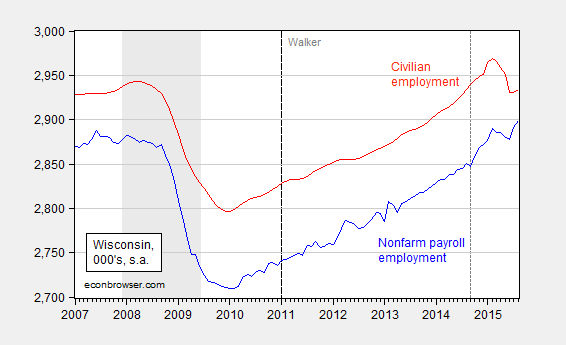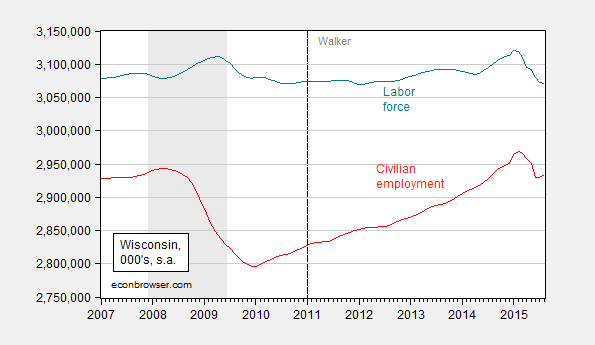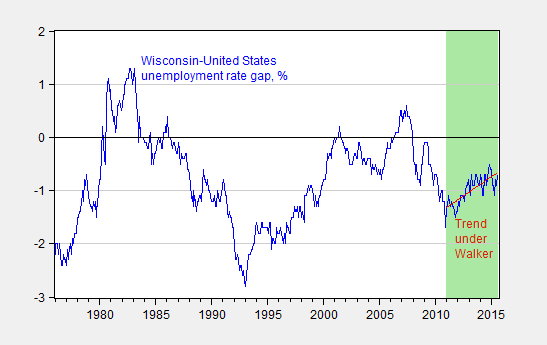The Department of Workforce Development released preliminary statistics for August today. Civilian employment remains below the 2008M03 peak; so is the labor force.
Figure 1: Wisconsin nonfarm payroll employment (blue), civilian employment (red), in 000’s, seasonally adjusted, Log scale. Dashed line denotes last period establishment series is QCEW benchmarked. Source: BLS, DWD.
Wisconsin nonfarm payroll employment has exceeded the prior peak by 9,000; but the broader measure of civilian employment in August is noticeably lower than the peak six months prior. Those who are familiar with the state-level establishment data know that current figures incorporate Quarterly Census of Employment and Wage (QCEW) data up to September 2014. My June estimates of what would happen if we used more recently released QCEW data through December 2014 implies the reported series should be moved down by 12,000, implying that when the benchmarking is implemented next year, it will turn out that August’s employment will not end up being above the prior peak.
The unemployment rate declined from 4.6% to 4.5%, and has been decreasing since the beginning of the year (5% in January). However some part of this is due to a sharply decreasing labor force.
Figure 2: Wisconsin labor force (teal), civilian employment (red), in 000’s, seasonally adjusted. Log scale. Source: BLS, DWD.
One caveat: the household survey estimates are subject to considerable sampling error, more so than the establishment survey (see here). Hence, trends should be the focus of attention — and what’s true is that Wisconsin’s estimated labor force has shrunk 1.6% since January (log terms). If the Governor’s objective is to encourage individuals to work, then there is a lack of progress on this front.
Finally, note that Wisconsin’s unemployment rate is rising relative to the National rate, following the trend that has been in place since Governor Walker took office.
Figure 3: Wisconsin minus US unemployment rate, in percentage points (blue), and linear trend in this differential over the Walker terms (red). Green shaded area Walker terms. Source: BLS, and author’s calculations.
None of these points are noted in the DWD release. However, the last bullet point in the memo does state:
Chief Executive Magazine ranked Wisconsin the “12th Best State for Business” in its annual survey of CEO’s, an increase of 2 spots over the 2014 ranking, and a big increase over 2010, when the state ranked 41st.
Update, 9/22: Anonymous aka Future President Donald Trump aka Scott Walker, American Patriot and Freedom Fighter aka BUT THE MODELS SHOW US!! aka (xo poa) aka YOLO! aka JS aka Joe asks for a comparison of labor force developments in US against Wisconsin. Here it is. Looks pretty bad to me.
Figure 4: Log US labor force (blue) and Wisconsin (red), 2011M01=0. NBER defined recession dates shaded gray. Source: BLS, NBER and author’s calculations.




Dr. Chinn,
Thank you for tracking the unique social and political experiment that is occurring in Wisconsin. The dismantling of institutions in the state (an excellent educational system, government unions, a fair work wage) that many Wisconsinites used to take pride in is a fascinating story that needs a wider telling. And, could serve as a model of what a governor and one-party-controlled legislature should not do. I look forward to any in-depth articles you publish summarizing your data. The drop in the labor force is interesting to me and I have to wonder if it is a sign of other issues.
By the way, I hope that the DWD drops that “12th Best State for Business” line that they have been adding for the last few releases. Touting that a 40,000 circulation industry magazine is ranking you number twelve out of 50 states seems like a dubious distinction.
Best regards,
http://www.pewtrusts.org/en/multimedia/data-visualizations/2014/fiscal-50#ind3
Love the new Figure 3! The simplest expression yet. Cogent, clear display of the impact of austerity. And by using the US as a whole, it gets around all the endless nit-pickery about specific state issues, such as KS oil rigs and so on. Can we get something like Figure 3 for State GDP-National GDP and other measures?
There are two dynamics at play: 1) change in population and 2) change in labor force participation rates.
Due to AGW climate change, portions populations have been leaving the temperate midwest and seeking subtropical or desert environments in the south and west. So, in absolute terms, midwest states will have more difficulty seeing absolute jobs growth. However, those AGW climate deniers who chose to remain in Wisconsin have enabled the state to return to close to the previous 2007 high participation rate (see my comment link above). Conversely, those AGW climate change believers who rushed to the subtropical and desert environments find themselves in states where the labor participation rate has struggled to recover.
😉
That does not make sense. Why would people go to hotter places because of climate change. It would seem that these places may become uninhabitable while midwestern winters would become milder.
What you call austerity I call sustainability. How would the numbers change if Wisconsin stopped funding its public pensions until it was as underwater as Illinois and Minnesota?
If taxes can be done on a postcard, many tax accountants/lawyers would be out of work.
Then, they’d have to get real jobs.
Maybe, they could get a job making cheese, beer, or paper in Wisconsin 🙂
Such as high finance?
It depends.
Too many people are wasting their time in the world of financial markets.
However, investors making corporations successful or more efficient is important.
Since when did investors make corporations “successful or more efficient”? Management and workers can make the companies efficient and successful, but when investors get into the details of the business you usually end up with a destroyed company that has been robbed of all its valuable assets (see Mitt Romney “the investor”)
Salvaging value isn’t the same as destroying value.
Investors aren’t investing to lose money.
When investors or their firms, which employ highly specialized analysts, get involved with the details of a business, you usually end up with a more competitive firm and more valuable assets.
Wall Street, for example, helped make Corporate America what it is today: Most successful on a global scale.
Can you do the national labor force as well?
Anonymous aka Future President Donald Trump aka Scott Walker, American Patriot and Freedom Fighter aka BUT THE MODELS SHOW US!! aka (xo poa) aka YOLO! aka JS aka Joe: I have done so. See added Figure 4. Wisconsin is careening downward as US labor force rises.
Good News! The nation’s loss is Wisconsin’s gain. Now Walker can get back to his job. So, Menzie, are you proud?
the state of wisconsin once again took the bullet for the benefit of the nation. thanks wisconsin. menzie simply exposed on this site what the rest of the nation realized over time as well about walker-not capable.
So the rest of the nation has realized over time Trump is capable and Hillary is a fraud?
nope. simply walker was not capable.
Anonymous aka Future President Donald Trump aka Scott Walker, American Patriot and Freedom Fighter aka BUT THE MODELS SHOW US!! aka (xo poa) aka YOLO! aka JS aka Joe: No, the GOP base + the GOP donors assessed Trump as capable, and Walker not.
Menzie,
Are you a secret member of the NSA? You seem to have a strange obsession with the computer history of people.
Ricardo: No, the software provides the information. The point is, I like people to know what views are associated with whom; for instance, that your views are provided by the same person who believed even until this year that Iraq had possessed WMDs that validated the 2013 US invasion of that country.